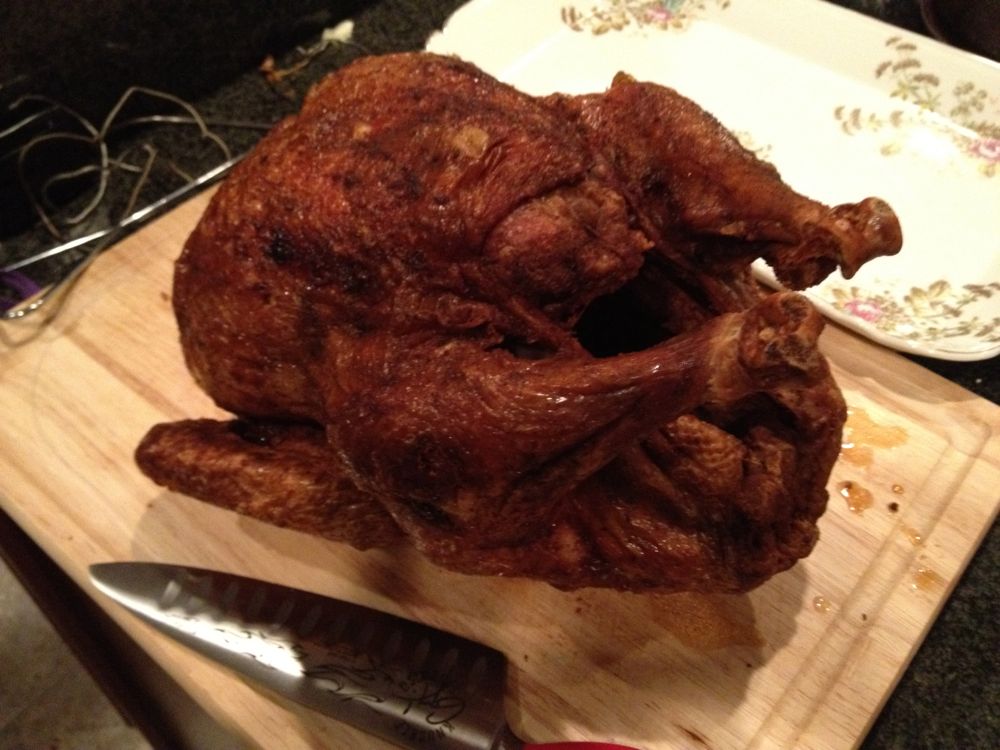Over 15 years ago, Brian’s Belly posted it’s original guide on deep frying a turkey. It’s popularity has prompted good discussion in the comments of the article and has added a lot of value to the conversation. Nestled among the questions and answers, there is a lot of great information.
But the comments of any blog can be a big tl;dr… and this particular post became a knowledge-base of hard-to-find tips. So with that in mind, I re-read and culled the best information that may not be in our deep fried turkey recipe and guide.
10. Success is 90% Preparation
Make sure you have everything you need for a successful fry a day or two before. Inject and rub your bird the night before. Have a good oil thermometer on hand. Have a backup. I had a thermometer gauge that was spinning in a circle one year. Have a good meat thermometer to test the internal temperature… the meat thermometer is the most important item you can own to make this–and every other–recipe successful. It takes approx. 20 minutes to heat the oil depending on the burner, the outside temperature and the starting temp of the oil.
9. All Turkeys Are Fair Game
There are always a lot of questions about store-brand birds vs. name-brand birds vs. organic or free-range. In my experience, as long as the bird is plump, it’s fryable. Most brands inject their turkeys with water so that when they roast they stay moist for the length that you have to cook it. Right on the label you will see a percentage of water added. When frying, you’re speeding up the cook time, so you don’t usually have to worry about low water percentage. The only time I ever had a little trouble was with a wild turkey that was shot the day before. Wild turkey is very much skin and bones, so cooking times were greatly adjusted for the skinny bird.
8. Chickens are Poultry Too
Frying a chicken instead of a turkey? Chickens take way longer per pound for some reason… almost twice as long… has to do with their density. I would not be afraid to go 5-7 minutes a pound at 350ºF, but check it early and often with a meat thermometer.
7. Your Pot Overfloweth
The size of the bird directly affects the size of the pot and the amount of oil it takes when cooking, and cooking safely. Some beginners may buy a big-ass pot for a big-ass bird when you may not need such a huge vessel or bounty (cook two medium birds instead of a single big one if you have to). If it’s your first time with a new pot, take the turkey before you prep it and put it in the pot and fill it with water until the legs are just showing (or the butt, whichever is higher)… maybe 2 inches above the water. Many people say to use oil instead of water, but good luck with that… gallons of cold oil dripping everywhere. Anyway, remove the bird from the water and that’s your oil fill line. Leaving at least two inches of clearance is smart… I have seen oil rapidly bubble that much; the heat from the oil below does the cooking to those skinny legs. And another thing… it’s easier to add a cup of oil room temp oil than remove several cups of boiling oil.
6. Cook the Legs, the Wings, the Whole Damn Bird
Size matters. When the turkey is more than 15 or 16 pounds you’re looking for trouble, especially if you’re a noob. I have definitely overcooked the legs before on larger birds, but one trick I’ve come to use is to tie the legs together and to the turkey stand with a bit of wire. It keeps the drumsticks snug against the breast and that makes a tiny bit of difference. Also, make sure you fold the wings back for the same reason. Then If you can keep your oil at 350º F you should be okay. Is the bird too big? If you really really have to, then cut the turkey into pieces and use a basket to retrieve the parts as they are done but there is truly no fun in chopping your turkey up. And there is no picturesque bird when you’re all done.
5. Common Sense is Not So Common
Most people blow off safety which is why there are so many fun videos online of how people burned their houses down while deep frying a turkey. If you literally “drop” your frozen turkey into boiling oil whilst in your garage… you betcha you’re gonna cause a fire. Put your burner and pot on a firm, level surface outside, many, many feet from your house. Keep kids, dogs, drunks and others with no sense of fear, pain or safety away from the cooking area. Keep an ABC fire extinguisher nearby for emergencies. What!? You don’t have a fire extinguisher at your house already? Are you stupid?
4. Turn Off the Burner Before You Lower the Turkey into the Oil!
Commenters BillC and Derek had a no-brainer of an idea: “I’ve found that it’s wise to turn off the burner when lowering the turkey into the oil. This will remove the risk of igniting any oil that may spill over the top of the pot while you’re lowering the turkey.” I think this is a great idea… a missing flame for a minute or so will do very little to the oil temp (the cold bird actually does more) and will make the process a lot safer. The Brian’s Belly lawyers don’t advise this, but if you bring your oil up a few degrees over 350º F before you turn off your burner, submerge your turkey and relight your burner, your recovery time back to 350ºF will be much quicker.
3. Carry-over Cooking is Your Friend
Many people don’t realize that when you cook–and then remove your food from its heat source, that is continues to cook. This is called carry-over cooking. When you fry a turkey, you’re looking for a target internal breast temperature of 170° that is recommended by the U.S. Dept. of Agriculture. Problem is, not only is that number extreme (because thermometers and heat sources differ so much) but that number is what you want the bird to eventually be, so you can remove it from the oil (heat source) when the temperature of the breast is around 160° Fahrenheit so it can continue to cook when covered in foil on your counter. This will also help with overcooking the legs and wings.
2. Over the River and Through the Woods: Traveling Turkey
Commenters Nick and Tom had some good advice for traveling with, and reheating your fowl. Wrap the bird in foil – if you have a cooler, it will work to insulate the bird as it travels. If you find you need to rewarm at your destination then put it in a pan with a rack and add some chicken broth below. Cover the pan with foil and re-warm in the oven at 200º F for about an hour for a 10-12lb. bird; longer for larger birds.
1. Oils Well That Ends Well
OK, I’m getting tired of catchy H2 headers. Luckily I’m at the last tip. Peanut oil is expensive. When you’re done with it, there is no reason to toss $40 bucks worth of oil. I really don’t use a fry pot all year long, but I don’t like waste. Here’s what I do nowadays… let the oil sit a day or so then I either pump or pour the oil through a funnel to several smaller containers and re-use the oil throughout the year for other smaller fry jobs. If you smoked the oil (it got too hot and started to smoke) then get rid of it. It can be recycled like motor oil.
Have a good fry!




[…] Over the years, the popularity of this guide has prompted good discussion in the comments… you guys have added a lot of value to the conversation. Nestled among the questions and answers, there is a lot of great information. But the comments of any blog can be a big tl;dr… So with that in mind, I re-read and culled the best information and posted it here: 10 Turkey Tips for your Thanksgiving Deep Fry. […]